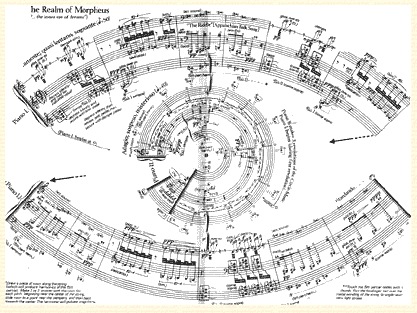George Crumb completed the final revisions for Zeitgeist (Six Tableaux for Two Amplified Pianos, Book I) in 1989. The work is approximately twenty-eight minutes in duration. It was commissioned by the Degenhardt-Kent piano duet. The first performance took place at the Charles Ives Festival in Duisburg, Germany in 1988.
After that. the composer reworked the piece to his liking. Like the rest of the Crumb catalog, this work includes enigmatic sounds and titles for the movements, such as “The Realm of Morpheus (” … the inner eye of dreams”).” The extended techniques involves the players reaching into the piano to attack the strings directly in order to achieve specific timbres that would not otherwise be available from without.
Like many of the composer’s earlier works, elements of the work suggest a coherent and exotic belief system or world view in all its eccentricities. Like his Makrokosmos series for amplified piano(s) in the 1970s, the listener is often drawn to the poetic allusions as potential clues to unlocking the arcane secrets of the composer’s mind.
The sound suggests some very concrete ideology or mystic purpose behind his clear yet unique musical formations. Webern had his naturalist Catholicism; Crumb’s point of departure is anybody’s guess. Part of its enduring interest is its lack of posturing. Scriabin, for example, reveled in the role of the eccentric, mystic genius, and played it up. Satie did something similar, though in a more modern and self-stylized way that was grounded in the Rosicrucians. It was less of a romantic cliché than was the hackneyed persona of his Russian peer.
Crumb has all the interior components of a similarly mystical artistic personality but none of the mannerisms or apparent affiliations. He is the anchor of his own spirit, and nothing else resembles his art, with the exception of a plethora of imitators.
When listening to a work such as Zeitgeist, being a world famous artist does not sound preoccupying to the composer. There is compassion to his music that does reflect back upon him as a leader of any wounded aesthetic congregation, as if he does not regard himself as the vital part of an equation consisting of listener, performer, and composer.
Above all, Crumb’s music is American. More precisely, it is nocturnal, pastoral Americana of the highest caliber, revealing a deeply compassionate, inquisitive, and independent imagination. A work such as Zeitgeist does not have more in common with the work of most composers from the United States than it does with the Europeans, with the exception of Charles Ives.
There is little in the scores themselves that verify this connection, but both demonstrate a relationship to the land that is difficult to pin down but easily recognized. Crumb uses fewer indigenous references than Ives, though the Zeitgeist’s fifth movement contains bits of an Appalachian folk song. It could be said that both composers felt less bound to music history than other composers; neither man sounds determined to either break with tradition or serve it.
The music simply is, and that is a rare quality. Even if the listener accepts these rather speculative conjectures, questions remain. Why Zeitgeist? What is the deeper meaning of its movements’ individual titles? It is the apparent importance of these questions that proves that the music is engaging. Many listeners are rarely satisfied to know a piece works. The rigor of Boulez’s syntax has everything to do with why the music works, and one can detect what is working by recognizing its nature, if not its particulars. Crumb’s music remains a mystery, a beautiful one, even with repeated listening.
[All Music Guide]
Excerpts: I have already published a post about the 3rd mov. (Monochord) here. Now go listen to the 4th and 6th.
George Crumb – Zeitgeist (Six Tableaux for Two Amplified Pianos, Book I)

